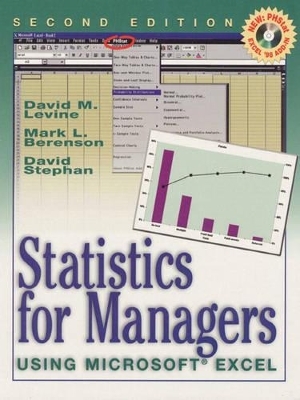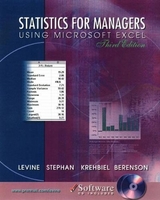
Statistics for Managers Using Microsoft Excel
Pearson
978-0-13-021218-4 (ISBN)
- Titel erscheint in neuer Auflage
- Artikel merken
For a one- or two-term course in Business Statistics at the undergraduate or graduate level.
Thoroughly integrating the use of Microsoft Excel, this streamlined text on business statistics uses an applied approach that focuses on the concepts and applications of statistics to the functional areas of business-accounting, marketing, management, and economics and finance. Revised to increase the emphasis on concepts and applications and to more seamlessly integrate coverage on Microsoft Excel, it offers detailed, step-by-step explanations on the use of Microsoft Excel to perform statistical analysis on every topic covered in the book and integrates numerous illustrations of Excel output and dialog boxes.
1. Introduction and Data Collection.
Why a Manager Needs to Know about Statistics. The Growth and Development of Modern Statistics. Statistical Thinking and Modern Management. Descriptive versus Inferential Statistics. Why Do We Need Data? Sources of Data. Types of Data. Types of Sampling Methods. Evaluating Survey Worthiness.
Case Study A: Alumni Association Survey.
Supplement Using Microsoft Excel for Statistical Analysis.
Overview. Getting Familiar with the User Interface. Getting Started with Microsoft Excel. Using Microsoft Excel Wizards and Add-Ins.
Summary. Key Terms.
2. Presenting Data in Tables and Charts.
Organizing Numerical Data. Organizing Numerical Data Using Microsoft Excel. Tables and Charts for Categorical Data. Generating Tables and Charts for Categorical Data Using Microsoft Excel. Tabulating and Graphing Bivariate Categorical Data. Generating Tables and Charts for Bivariate Categorical Data Using Microsoft Excel. Graphical Excellence.
Summary. Key Terms. Chapter Review Problems. Team Project.
The Springville Herald Case.
3. Summarizing and Describing Numerical Data.
Exploring Numerical Data and Their Properties. Measures of Central Tendency, Variation, and Shape. Generating Measures of Central Tendency, Variation, and Shape Using Microsoft Excel. Exploratory Data Analysis. Exploratory Data Analysis in Microsoft Excel. Obtaining Descriptive Summary Measures from a Population. Generating Descriptive Measures in a Population Using Microsoft Excel. Recognizing and Practicing Proper Descriptive Summarization and Exploring Ethical Issues.
Summary. Key Terms. Chapter Review Problems. Team Project.
Case Study B: State Alcoholic Beverages Oversight Board Study on Beers.
Springville Herald Case.
4. Basic Probability and Discrete Probability Distributions.
Basic Probability Concepts. Calculating Probabilities Using Microsoft Excel. Conditional Probability. Bayes' Theorem. The Probability Distribution for a Discrete Random Variable. Binomial Distribution. Calculating Binomial Probabilities Using Microsoft Excel. Poisson Distribution. Calculating Poisson Probabilities Using Microsoft Excel. Hypergeometric Distribution (Optional Topic.) Calculating Hypergeometric Probabilities Using Microsoft Excel. Covariance and its Application in Finance (Optional Topic). Calculating the Covariance Using Microsoft Excel. Ethical Issues and Probability.
Summary. Key Terms. Chapter Review Problems.
Springville Herald Case.
5. Decision Making.
The Payoff Table and Decision Trees. Calculating Opportunity Loss Using Microsoft Excel. Criteria for Decision Making. Generating Criteria for Decision Making Using Microsoft Excel. Decision Making with Sample Information. Utility.
Summary. Key Terms. Chapter Review Problems.
6. The Normal Distribution and Sampling Distributions.
The Normal Distribution. Calculating Normal Probabilities Using Microsoft Excel. Assessing the Normality Assumption. Generating Exponential Probabilities Using Microsoft Excel. Introduction to Sampling Distributions. Sampling Distribution of the Mean. Simulating Sampling Distributions Using Microsoft Excel. Generating Random Samples Using Microsoft Excel. Sampling Distribution of the Proportion. Sampling from Finite Populations.
Summary. Key Terms. Chapter Review Problems. Team Project.
Springville Herald Case.
7. Confidence Interval Estimation.
Confidence Interval Estimation for the Mean (…s Known). Calculating the Confidence Interval Estimate for the Mean (…s Known) Using Microsoft Excel. Confidence Interval Estimation for the Mean (…s Unknown). Calculating the Confidence Interval Estimate for the Mean (…s Unknown) Using Microsoft Excel. Confidence Interval Estimation for the Proportion. Calculating the Confidence Interval Estimate for the Proportion Using Microsoft Excel. Determining Sample Size. Determining the Sample Size for Estimating Using Microsoft Excel. Estimation and Sample Size Determination for Finite Populations. Using the Finite Correction Factor in Microsoft Excel. Applications of Confidence Interval Estimation in Auditing. Calculating the Confidence Interval Estimate for the Population Total Using Microsoft Excel. Calculating the Confidence Interval Estimate for the Total Difference Using Microsoft Excel. Confidence Interval Estimation and Ethical Issues.
Summary. Key Terms. Chapter Review Problems. Team Project.
Springville Herald Case.
8. Fundamentals of Hypothesis Testing: One-Sample Tests.
Hypothesis-Testing Methodology. Z Test of Hypothesis for the Mean (…s Known). The p-Value Approach to Hypothesis Testing. Performing the Z Test of Hypothesis for the Mean (…s Known) Using Microsoft Excel. A Connection between Confidence Interval Estimation and Hypothesis Testing. One-Tailed Tests. Performing a One-Tailed Z Test of Hypothesis for the Mean (…s Known) Using Microsoft Excel. t Test of Hypothesis for the Mean (…s Unknown). Performing the t Test of Hypothesis for the Mean (…s Unknown) Using Microsoft Excel. Z Test of Hypothesis for the Proportion. Performing the Z Test of Hypothesis for the Proportion Using Microsoft Excel. Potential Hypothesis-Testing Pitfalls and Ethical Issues.
Summary. Key Terms. Chapter Review Problems. Team Project.
9. Two-Sample Tests with Numerical Data.
Comparing Two Independent Samples: t Tests for Differences in Two Means. Performing the Pooled-Variance t Test for Differences in Two Means Using Microsoft Excel. F Test for Differences in Two Variances. Performing the F Test for Differences in Two Variances Using Microsoft Excel. Comparing Two Related Samples: t Test for the Mean Difference. Performing the t Test for the Mean Differences Using Microsoft Excel. Wilcoxon Rank Sum Test for Differences in Two Medians (Optional Topic). Performing the Wilcoxon Rank Sum Test for Differences in Two Medians Using Microsoft Excel.
Summary. Key Terms. Chapter Review Problems. Team Project.
10. ANOVA and Other c-Sample Tests with Numerical Data.
The Completely Randomized Model: One-Factor Analysis of Variance. Performing the One-Factor Analysis of Variance Using Microsoft Excel. Performing the Tukey-Kramer Procedure Using Microsoft Excel. The Factorial Design Model: Two-Way Analysis of Variance. Performing the Two-Factor Analysis of Variance Using Microsoft Excel. Kruskal-Wallis Rank Test for Differences in c Medians (Optional Topic). Performing the Kruskal-Wallis Rank Test for Differences in c Medians Using Microsoft Excel.
Summary. Key Terms. Chapter Review Problems. Team Project.
Case Study C: Test Marketing and Promoting a Ball-Point Pen.
Springville Herald Case.
11. Two-Sample and c-Sample Tests with Categorical Data.
Z Test for Differences in Two Proportions. Performing the Z Test for Differences in Two Proportions Using Microsoft Excel. …c2 Test for Differences in Two Proportions. Performing the c2 Test for Differences in Two Proportions Using Microsoft Excel. …c2 Test for Differences in c Proportions. Performing c2 Tests for Differences in c Proportions Using Microsoft Excel. …c2 Test of Independence. Performing c2 Tests of Independence Using Microsoft Excel.
Summary. Key Terms. Chapter Review Problems. Team Project.
Case Study D: Airline Satisfaction Survey.
Springville Herald Case.
12. Statistical Applications in Quality and Productivity Management.
Quality and Productivity: A Historical Perspective. Deming's Fourteen Points: A Theory of Management by Process. The Theory of Control Charts. Control Chart for the Proportion of Nonconforming Items - The p Chart. Generating a p Chart Using Microsoft Excel. The Red Bead Experiment: Understanding Process Variability. Control Charts for the Range (R) and the Mean (X). Generating Control Charts for the Mean and the Range Using Microsoft Excel.
Summary. Key Terms. Chapter Review Problems.
Case Study E: The Harnswell Sewing Machine Company.
Springville Herald Case.
13. The Simple Linear Regression Model and Correlation.
Types of Regression Models. Determining the Simple Linear Regression Equation. Generating Scatter Diagrams Using Microsoft Excel. Calculating the Simple Linear Regression Coefficients Using Microsoft Excel. Measures of Variation. Assumptions. Residual Analysis. Generating Residual Plots Using Microsoft Excel. Measuring Autocorrelation: The Durbin-Watson Statistic. Calculating the Durbin-Watson Statistic Using Microsoft Excel. Inferences about the Slope. Estimation of Predicted Values. Estimating Predicted Values Using Microsoft Excel. Pitfalls in Regression and Ethical Issues. Computations in Simple Linear Regression. Correlation - Measuring the Strength of the Association. Calculating the Correlation Using Microsoft Excel.
Summary. Key Terms. Chapter Review Problems.
Case Study F: Predicting Sunday Newspaper Circulation.
Springville Herald Case.
14. Multiple Regression Models.
Developing the Multiple Regression Model. Residual Analysis for the Multiple Regression Model. Testing for the Significance of the Multiple Regression Model. Inferences Concerning the Population Regression Coefficients. Testing Proportions of the Multiple Regression Model. Calculating the Coefficients of Partial Determination Using Microsoft Excel. The Curvilinear Regression Model. Creating Curvilinear Regression Models Using Microsoft Excel. Dummy-Variable Models. Creating Dummy-Variable Models Using Microsoft Excel. Using Transformation in Regression Models. Generating Transformations Using Microsoft Excel. Collinearity. Calculating the Variance Inflationary Factor Using Microsoft Excel. Model Building. Performing Best-Subsets Analysis Using Microsoft Excel. Pitfalls in Multiple Regression and Ethical Issues.
Summary. Key Terms. Chapter Review Problems.
Case Study G: Predicting Moving Time at the EastWest Moving Company.
Case Study H: The Mountain States Potato Company.
15. Time-Series Analysis.
The Importance of Business Forecasting. Component Factors of the Classical Multiplicative Time-Series Model. Smoothing the Annual Time-Series. Calculating Moving Averages Using Microsoft Excel. Generating Exponential Smoothing Using Microsoft Excel. Least-Squares Trend Fitting and Forecasting. Performing Least-Squares Trend Fitting Using Microsoft Excel. Autoregressive Modeling for Trend Fitting and Forecasting. Generating Autoregressive Models Using Microsoft Excel. Choosing an Appropriate Forecasting Model. Calculating the Mean Absolute Deviation (MAD) Using Microsoft Excel. Time-Series Forecasting of Monthly or Quarterly Data. Generating Dummy Variables for the Time-Series Forecasting of Monthly or Quarterly Data. Pitfalls Concerning Time-Series Analysis and Ethical Considerations.
Summary. Key Terms. Chapter Review Problems.
Case Study I: Currency Trading.
Springville Herald Case.
Answers to Selected Problems.
Appendices.
A. Review of Arithmetic and Algebra.
B. Summation Notation.
C. Statistical Symbols and Greek Alphabet.
D. Special Data Set.
E. Tables.
F. Documentation for CD-ROM Files.
Index.Excel Index.
| Erscheint lt. Verlag | 2.6.2000 |
|---|---|
| Sprache | englisch |
| Maße | 200 x 250 mm |
| Gewicht | 2005 g |
| Themenwelt | Informatik ► Office Programme ► Excel |
| Mathematik / Informatik ► Mathematik ► Finanz- / Wirtschaftsmathematik | |
| Mathematik / Informatik ► Mathematik ► Statistik | |
| ISBN-10 | 0-13-021218-0 / 0130212180 |
| ISBN-13 | 978-0-13-021218-4 / 9780130212184 |
| Zustand | Neuware |
| Informationen gemäß Produktsicherheitsverordnung (GPSR) | |
| Haben Sie eine Frage zum Produkt? |
